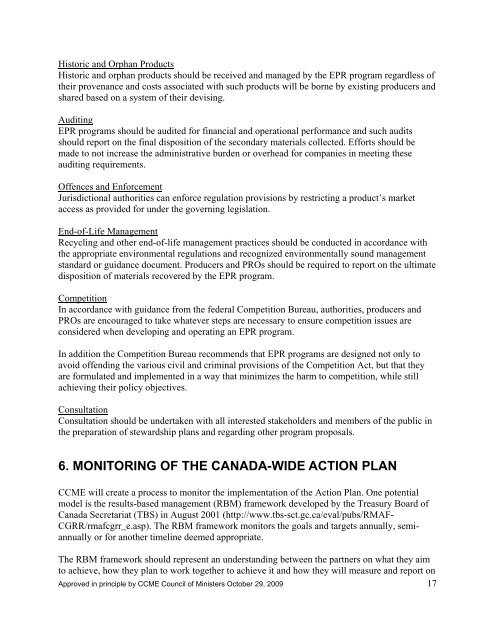Canada-Wide Action Plan for Extended Producer ... - CCME
Canada-Wide Action Plan for Extended Producer ... - CCME
Canada-Wide Action Plan for Extended Producer ... - CCME
You also want an ePaper? Increase the reach of your titles
YUMPU automatically turns print PDFs into web optimized ePapers that Google loves.
Historic and Orphan Products<br />
Historic and orphan products should be received and managed by the EPR program regardless of<br />
their provenance and costs associated with such products will be borne by existing producers and<br />
shared based on a system of their devising.<br />
Auditing<br />
EPR programs should be audited <strong>for</strong> financial and operational per<strong>for</strong>mance and such audits<br />
should report on the final disposition of the secondary materials collected. Ef<strong>for</strong>ts should be<br />
made to not increase the administrative burden or overhead <strong>for</strong> companies in meeting these<br />
auditing requirements.<br />
Offences and En<strong>for</strong>cement<br />
Jurisdictional authorities can en<strong>for</strong>ce regulation provisions by restricting a product’s market<br />
access as provided <strong>for</strong> under the governing legislation.<br />
End-of-Life Management<br />
Recycling and other end-of-life management practices should be conducted in accordance with<br />
the appropriate environmental regulations and recognized environmentally sound management<br />
standard or guidance document. <strong>Producer</strong>s and PROs should be required to report on the ultimate<br />
disposition of materials recovered by the EPR program.<br />
Competition<br />
In accordance with guidance from the federal Competition Bureau, authorities, producers and<br />
PROs are encouraged to take whatever steps are necessary to ensure competition issues are<br />
considered when developing and operating an EPR program.<br />
In addition the Competition Bureau recommends that EPR programs are designed not only to<br />
avoid offending the various civil and criminal provisions of the Competition Act, but that they<br />
are <strong>for</strong>mulated and implemented in a way that minimizes the harm to competition, while still<br />
achieving their policy objectives.<br />
Consultation<br />
Consultation should be undertaken with all interested stakeholders and members of the public in<br />
the preparation of stewardship plans and regarding other program proposals.<br />
6. MONITORING OF THE CANADA-WIDE ACTION PLAN<br />
<strong>CCME</strong> will create a process to monitor the implementation of the <strong>Action</strong> <strong>Plan</strong>. One potential<br />
model is the results-based management (RBM) framework developed by the Treasury Board of<br />
<strong>Canada</strong> Secretariat (TBS) in August 2001 (http://www.tbs-sct.gc.ca/eval/pubs/RMAF-<br />
CGRR/rmafcgrr_e.asp). The RBM framework monitors the goals and targets annually, semiannually<br />
or <strong>for</strong> another timeline deemed appropriate.<br />
The RBM framework should represent an understanding between the partners on what they aim<br />
to achieve, how they plan to work together to achieve it and how they will measure and report on<br />
Approved in principle by <strong>CCME</strong> Council of Ministers October 29, 2009 17
















